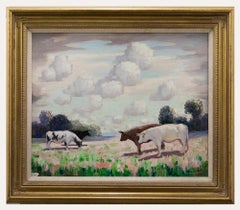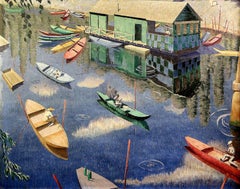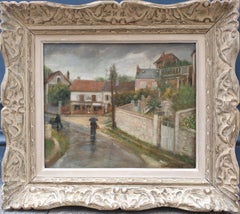Norman Lloyd Art
Norman Lloyd was born in 1895 near Newcastle, New South Wales, where he attended school. He left school in 1911 and started to work and study painting with Julian Ashton and James R. Jackson in Sydney. On his 21st birthday in 1916, he enlisted with the Australian Imperial Forces. He was transported to Europe, where he was seriously wounded in battle a year later. After returning to Sydney in February 1918, he took up painting lessons at the Julian Ashton Art School again. From 1921–26, Lloyd exhibited with galleries in Sydney and Melbourne, showing landscapes and Sydney harbor scenes painted in the more traditional style of his teachers. From 1926–29, Lloyd visited Europe and traveled widely in Italy and France, exhibiting in the UK, France and Australia, culminating in a solo exhibition at Macquarie Galleries in Sydney. In the 1930s, Lloyd migrated to London with his wife Edith for good, setting up a boarding house in upmarket St Johns Wood and establishing himself quickly in the new society, being a kind, generous and interested man with a broad horizon. His mansion became a meeting point and home for many Australian ex-pats, among them painters Will Ashton, Alison Rehfisch and George Duncan. The Lloyds hosted pianist Nancy Weir, and war correspondent Harold Fyffe was a close friend, who introduced Lloyd to H. G. Wells and George Bernard Shaw. Lloyd established himself also professionally when he was elected member of the exclusive Royal Institute of Oil Painters (ROI) in 1936 and of the London Sketch Club, over which he presided during 1941–42. He also kept his connection with Australia by becoming a Fellow of the Royal Art Society of New South Wales, and in 1949 Henry Hanke’s portrait of Lloyd was chosen to be hung in the Archibald Prize of the Art Gallery of New South Wales. From 1933 until 1970, Lloyd exhibited regularly with the ROI and showed at the Royal Academy of London. The titles testify of Lloyd’s love for Mediterranean Europe - Italy, Spain, France, Turkey and Morocco, inspiring joyful land, sea and mountainscapes, in a style that evoked impressionism. Lloyd was a prolific painter who was able to paint fast, preferring textural oil and pastels. From 1947 onwards, Lloyd spent the summers with Zénaide Chaumette, whom he had met in Paris after the war in the heart of France in Chassignolles. This liaison strengthened his connection with France and probably led to his exhibiting at several Salons of the Société des Artistes Français from 1947–62, and also at the Salon d’Hiver in Paris. After the death of Zénaide Chaumette in 1954, Lloyd was willed Chaumette’s house in Chassignolles, and it seems that he moved there permanently in 1974, at the age of 80, after the death of his wife, Edith. He was later found wandering in a confused state in Paris unable to speak, having had a stroke. Fortunately, he was able to communicate that he had friends in Chassignolles, which led to the involvement of a nephew in England. The nephew was contacted and arrangements were made for him to live in a nursing home in Yorkshire, where he died on 5 March 1983. The ‘Times’ of London printed a short obituary. In 1989–1990, Lloyd’s work was shown at Savill Galleries in Sydney alongside several important Australian artists. In 1990, Christopher Day Gallery, Sydney, dedicated a solo exhibition to Norman Lloyd, and 1991 saw his work again at a group exhibition in Deutscher Fine Art, Melbourne. Lloyd’s work is now represented in the Art Gallery of Western Australia, the Queensland Art Gallery, the University of Sydney Art Collection and numerous private collections in Australia, Europe and the US.
20th Century Norman Lloyd Art
Oil
20th Century Norman Lloyd Art
Oil
Mid-20th Century Art Deco Norman Lloyd Art
Oil, Canvas
1920s Art Deco Norman Lloyd Art
Oil
20th Century Art Deco Norman Lloyd Art
Oil
1920s Art Deco Norman Lloyd Art
Oil
18th Century Norman Lloyd Art
Oil
Late 19th Century Impressionist Norman Lloyd Art
Oil
2010s Art Deco Norman Lloyd Art
Oil Pastel, Oil, Acrylic, Watercolor, Gouache
20th Century Hudson River School Norman Lloyd Art
Oil
2010s Art Deco Norman Lloyd Art
Oil Pastel, Oil, Acrylic, Watercolor, Gouache
17th Century Old Masters Norman Lloyd Art
Oil, Wood Panel
21st Century and Contemporary Realist Norman Lloyd Art
Oil
Early 1900s Art Deco Norman Lloyd Art
Oil, Wood Panel
1730s Italian School Norman Lloyd Art
Canvas, Oil



